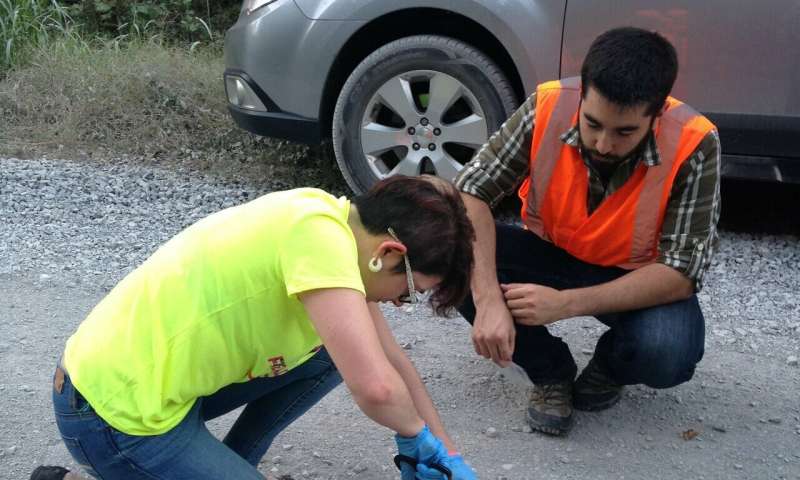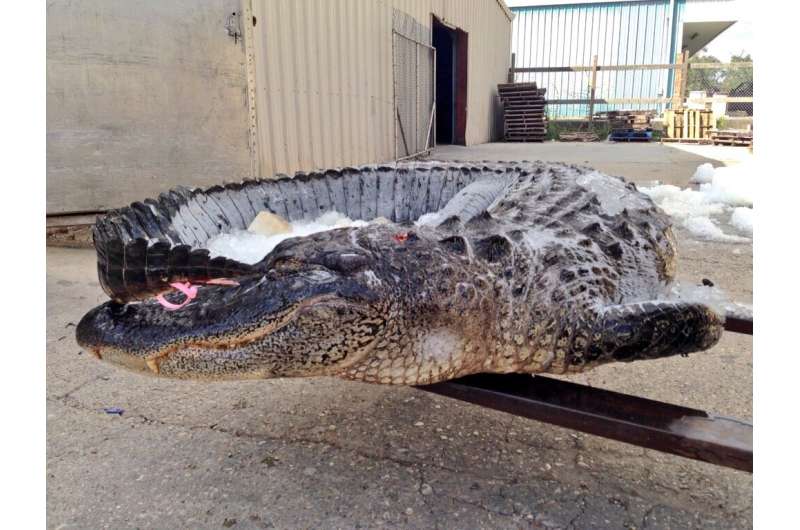Want to learn about dinosaurs? Pick up some Louisiana roadkill

Fossil-hunting can be grueling, but it's usually not gross. Paleontologists typically work with things that have been dead for millions of years, mineralized into rock and no longer smelly. At the end of a day in the field, the researchers just have to dust themselves off and wash muddy boots and sweaty clothes. But for a new study delving into the ecosystems that dinosaurs lived in, a team of paleontologists found themselves scraping swamp rabbits and armadillos off the Louisiana highway.
"We want to know what the dinosaurs ate and what their habitats were like, but before we can do that, we need to understand what their environment was like. We need to look at similar environments today," says Thomas Cullen, the lead author of the study in Royal Society Open Science and a postdoctoral researcher at Chicago's Field Museum. More specifically, Cullen and his team needed to look at the remains of animals living in those similar environments today. Even more specifically, they needed to look at the chemical makeup of those animals' remains.
"You are what you eat, more or less," explains Cullen, who completed his doctorate at the University of Toronto and the Royal Ontario Museum, under the supervision of co-author David Evans. "There are naturally occurring variants of elements, called stable isotopes—versions of elements' atoms that are lighter or heavier depending on how many neutrons they contain. Different plants contain different relative amounts of heavy or light stable isotopes for particular elements, such as carbon and oxygen, and when animals eat those plants, or eat other animals that eat those plants, they incorporate those isotopes into their tissues."
And those isotopes don't necessarily go away when an animal dies, or even when it's fossilized. Stable isotopes preserved in the bones or teeth of animals can stay intact for tens of millions of years, meaning that scientists could analyze the isotopes present in a fossil and get some sense of what that animal ate and where it fell in the food chain. Isotopes could ostensibly be a window into dinosaurs' lives.
There's a potential flaw in this premise, though—there's a lot that scientists don't know about the way dinosaurs and other extinct animals partitioned up habitat and resources in their ecosystems, and it's not clear how well this kind of isotopic analysis, often used for mammals living in drier forest or plains settings, would be able to pinpoint the diets of a mix of different animal groups living in a swampy, fragmented landscape. Cullen and his team's solution was to check the analytical method against a modern-day ecosystem similar to the ones that dinosaurs lived in, to see if the isotopic analysis could correctly predict the diets of modern animals.

"We wanted to check if the stable isotope methods that we typically have available really work for dinosaur paleontology, and particularly for characterizing ancient wetland ecosystems. So, we checked those methods in a modern coastal floodplain forest ecosystem where we already roughly know the right answers," says Cullen. "It was a due diligence exercise, and it involved playing with a lot of roadkill."
The team headed to the Atchafalaya River Basin, the nation's largest swamp. It's smack dab in the middle of Louisiana, and roads cutting through the swamps and bayous make for a steady supply of roadkill. "Originally, we had planned a trip down to the area to meet up with people from the Louisiana Department of Wildlife and Fisheries, researchers and collections staff at local universities and museums, and a local naturalist. But the Fish and Wildlife people were kind enough to grant us a special use permit to collect samples, so we spent a few days driving around and collecting roadkill in between meetings," says Cullen. "We didn't really expect it to be too successful, but it actually ended up being super effective. We collected something like 40-50 samples representing about 15 species in the first couple days of driving around." Dozens more followed, along with specimens provided by universities and museums, donated from local naturalists, and even including gar and alligator samples given by the Landry family, who star in the reality show Swamp People.
Collecting a hundred-odd roadkill specimens was a new challenge for the team, even though Cullen notes that "biologists have a reputation for constantly picking up dead things." "The first few were really gross," he recalls. "We found a raccoon that looked fine at first, but its fur was crawling with maggots, so we went to its mouth to pull out a tooth instead. The whole jaw slid out of the mouth. It was really revolting, but we got desensitized."
Once the tissue samples were back in the lab, the team analyzed them in a mass spectrometer, a machine that analyzes the atomic masses of elements present in a sample and provides ratios of heavy to light stable isotopes of the elements of interest. The results that came back were a little fuzzy—if the researchers hadn't gone in knowing what raccoons and gators eat, the analysis based on the isotopes wouldn't have been able to tell them precisely. "We found out that the system is not very cut and dry. Ideally, you'd be able to distinguish each animal by what it was eating and where in the habitat it was living. The problem is, out in that fragmented swampy land, animals have very diverse diets, so they don't segregate in nice little boxes," says Cullen. "With fossils, we can't go out and watch what an animal's eating or exactly what habitat it prefers, so we should be conservative with our interpretations from this sort of data."
With the resources currently available, conventional stable isotopes like carbon and oxygen might not be the perfect tool for piecing together the fine-scale diets and preferences of dinosaurs. However, Cullen notes, future research tracking changes in stable isotope patterns over longer time periods, and using isotopes that better track food web structure, may yield more promising results. "The conventional way of studying fossil stable isotope ecology , using carbon and oxygen, may not be as suitable for dinosaurs, or any animal, in coastal floodplain forests as we'd hoped," says Cullen. "Actually solving this problem may require the use of more exotic stable isotope systems that act the same way nitrogen does in soft tissues, by concentrating or depleting up a food chain, but that are able to preserve in hard tissues, and as a result fossilize."
When asked if the study's ultimate goal, of finding better ways to learn what dinosaurs ate, was worth pulling the teeth out of rotting raccoons in the Louisiana sun, Cullen said, "The geological record gives us a chance to understand how ecology evolves and changes over time and responds to things like climate change. By understanding ecology on as fine a scale as possible, in both the past and the present, we can make predictions about what will happen in the future." Besides, he notes, "It's always cool to think about what dinosaurs were doing."
More information: Stable isotopic characterization of a coastal floodplain forest community: a case-study for isotopic reconstruction of Mesozoic vertebrate assemblages, Royal Society Open Science(2019). rsos.royalsocietypublishing.or … /10.1098/rsos.181210
Journal information: Royal Society Open Science
Provided by Field Museum



















